
From alpine lakes to snow-capped mountain passes, a bike trip in Kyrgyzstan is as beautiful as it is tough!
Kazakhstan border – Karakol – Issyk Kul Lake – Tosor Pass – Narin – Kaserman … Jalalabad – Osh – Papan – Peshchera Gorge – Osh
566 km cycled
July-August 2024
Watch the video!
Visa requirements and getting there
EU and Swiss citizens do not require a visa in Kyrgyzstan for stays of up to 60 days. We flew with Pegasus to Almaty in Kazakhstan and cycled the 300km from there to the north-eastern Kyrgyzstan border not far from China. Pegasus also fly from Zurich to Bishkek and Osh via Turkey.


You're going where?
Untamed mountainous scenery, alpine meadows, grassy steppes, glaciers and lakes have been luring hikers and bikers to Kyrgyzstan for years.
This former member of the Soviet Union is landlocked by China, Kazakhstan, Uzbekistan and Tajikistan, has a population of seven million and is about five times the size of Switzerland.
To sleep in a yurt has been a dream of Darina’s for years, and Kyrgystan was going to help tick that box!


First impressions
After our leisurely cycle in Kazakhstan, we were promptly introduced to what Kyrgyzstan is all about. The scenery appeared a whole lot greener than what we had seen across the border, and the mountains loomed significantly higher. We were greeted with rain and our tyres got stuck in mud. Even on our first day, we were reduced to pushing up a steep gravel incline. Kyrgzyzstan was going to be a whole different ball game!


A little history
Kyrgyzstan, strategically located between the East and West, played an important role in the Silk Road trading route from 130BC to 1453AD. After a devastating 200-year period under Mongol domination, followed by independence and further invasions from neighbouring tribes, Kyrgyzstan became part of the Russian Empire in 1876. It has been independent since 1991.



Karakol
We headed for Karakol, established as a garrison town during the Tsarist Russian Empire in the 19th Century. A magnificent wooden Orthodox Church, built in 1895 to serve the Russian troops sent to Karakol, is one of the main attractions in town.


The Dungan Mosque is no less impressive. It was completed in 1910 by Dungan Muslims fleeing persecution in China. Instead of a minaret, this unique wooden building is topped with a pagoda and not a single nail was used in its construction!


At the market we were curious about the different sized hearts on sale in the meat section, one being a whole lot bigger than the others: That of the horse!


Traffic
Entering and leaving Karakol is not much joy because of the narrow road, poor surface and speeding traffic. Respect for cyclists is not something that has priority in this neck of the woods. Luckily, we were able to use the sand hard shoulder and survived the experience!

A dream come true!
Feeling a little under the weather with a nasty cold, Darina insisted on a couple of rest days once we reached the beautiful Issyk Kul Lake. And what better way to recharge your batteries than to snuggle up in a traditional yurt with home-cooked meals a hop, skip and jump from the lake shore.

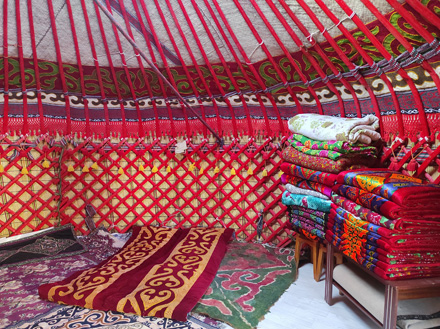
Issyk-Kul
182km long and 60km wide, Issyk Kul is the second largest mountain lake in the world after Lago Titicaca in Peru/Bolivia. Our climbing had paid off and here at 1,600 masl we got the rest and relaxation we needed before tackling the major challenge of the trip.


Never again!
Leaving the shores of Issyk Kul, the snowcapped peaks of the Tian Shan were beckoning, and the track appeared quite doable.
As we approached 3,000 masl, Darina was already feeling the absence of oxygen and our two-inch tyres started to lose traction on the gravel/sand track. And as the snow-capped peaks appeared in full view, the gradient increased significantly.


The only way is up!
Now we needed two to a bike to make it up the climb. Push for 15 seconds. Stop, pant and puff for 30 seconds. Repeat. On our many breathless breaks we vowed that this would be our last such expedition. Only a fool would repeat such an ordeal … Hail graced us as we struggled to the summit: Tosor Pass, 3,893 masl.



And the reward!
Black clouds were rolling in, so we rattled and skidded downhill through the rough riverbed track that lay ahead. And boy what a magnificent display of nature awaited us! Our reward was the most wondrous valley of rushing streams, mighty glaciers, towering mountains, wild-flower meadows and roaming horses.



Lesson learned!
All forgiven? Certainly! And forgotten? Never! Lesson learned: There shall be no more off-road adventures for us … without 2.6-inch knobbly tyres!


What a ride!
What goes up, must come down, right? Well, it was that downhill promise of 2,000 altitude metres that kept us going on Tosor. With every pant, we dreamed of freewheeling the whole 170km to Naryn!


Where are we?
And while the Tian Shan had other ideas, the spectacular scenery that emerged more than compensated for the numerous hiccups in that coveted descent. At times we had flashbacks to Norway, other times to Iceland. And then it felt as if we had been transported to Patagonia! The road to Naryn is definitely not one to be rushed!



The locals
The nomadic Kyrgyz move up and down the mountains with their livestock depending on the season, drink fermented horse milk and live in yurts. Once leaving the lake shore, locals were low on the ground. However, we were greeted daily by friendly herders on horseback, who at times rode alongside us and even guided us around river crossings.
Communication was basic as our Russian and Kyrgyz was limited to the essentials, and without Internet in this remote region, we couldn’t rely on Google translate. Let’s say by the time we reached Naryn, our creativity at expressing ourselves had reached a whole new level!
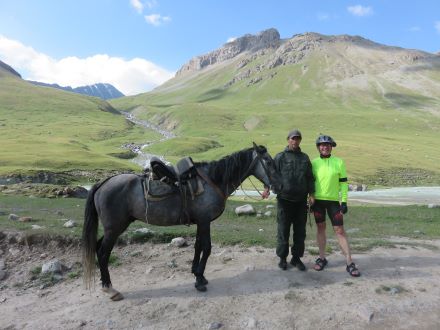


The road to Kazarman
Labelled on Google Maps as “the most beautiful road in the country”, the road from Naryn to Kazarman was next up. And “up” was the operative word as soon as we left the Naryn River at 1,600masl.
It was a long climb through arid, barren terrain with quite a few hike-the-bike stretches, where our touring tyres had no traction. Interestingly, once we crossed the pass at 2,800masl, lush green velvety hills glowed in the evening sun.



The “downhill” wasn’t quite a roll in the park and temperatures reaching 38 Celsius really put us to the test. Kyrgyzstan’s magnificent scenery doesn’t come for free!


Transfer
The soaring temperatures and promises of a “horrible road” across yet another 3,000m mountain pass did little to entice us to take on the challenge. We opted for a lift to Jalalabad, where temperatures were reaching 40 Celsius. Our bikes went into a delivery van, and we travelled in an Audi, whose engine was put to the test, resulting in a 5-hour journey for the 150km. Absolutely no regrets about that decision!
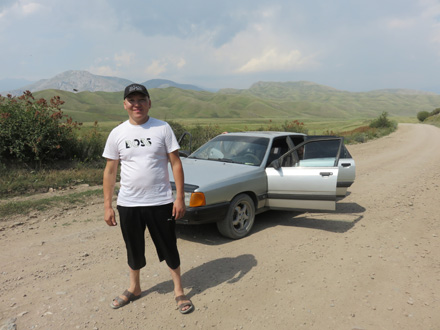

Cyclists
Kyrgyzstan is still quite the magnet for cyclists from all corners of the world, and as long as the Silk Road Mountain Race in based in this wonderful part of the world, there will always be an interest in following the 2,000km route with 28,000m of elevation gain. With such numbers, our modest route pales into insignificance; we are certainly no contenders for such an ordeal!
Leaving Jalalabad, we bumped into Oleś, cycling from Australia to Europe. A well-seasoned traveller already on the road for 18 months, Oleś sets himself apart from the crowd in that he travels with his guitar. We were lucky to enjoy his company and serenades for the remainder of our trip.



A loop south of Osh
Now that we had taken the transfer, we had a few extra days at our disposal and so we did a loop into the hills south of Osh. It was characterised by much easier terrain, great camping, an abundance of local produce, friendly folk and amazing hospitality. What a perfect end to a trip that delivered on many accounts and certainly put us to the test!
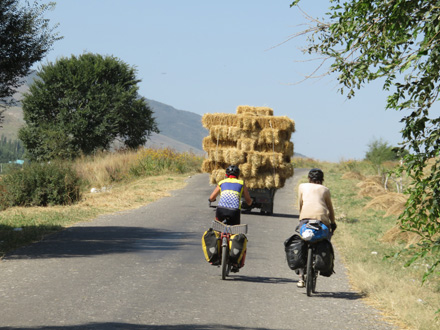

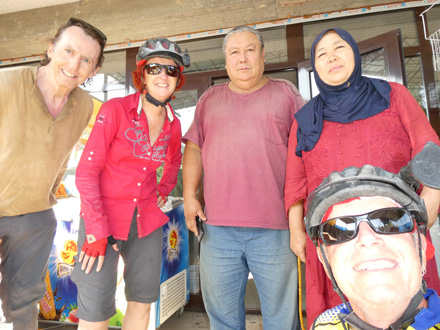
Accommodation
While wild camping is the way to go in Kyrgyzstan, we did avail of the delightful opportunity to sleep in a yurt a few times during the trip. Overnight in a yurt with a hearty breakfast cost us generally 15€ per person, and a simple double room with shared bathroom came to about 1,200Som (13€).


Food
In the towns and yurts we ate quite well. The dishes were often meat, noodle and soup based, and portions were generous. Main courses cost between 220-360 Som (2.50-4.00€). For those expeditions when we were 4-5 days between shops, we stocked up on cous-cous, porridge, noodles, rye bread, vegetables, dried fruit, nuts and even dried or canned horsemeat. Water was available on a daily basis and we filtered from streams and even chocolate-coloured rivers without any problems.
One peculiarity in Central Asia is Kurt! These fermented cheese balls made from cow, sheep, horse, goat or camel milk are as hard as rocks and best crumbled into soups or grated on salads like Parmesan cheese. Not intened to be eaten like most Swiss cheeses, Kurt’s attempt at self-canabalisation was quickly aborted as he failed to bite into the rock-hard intensely salty ball. Actually, the locals say that the salty taste stems from rubbing them in their armpits after drying them in the sun!









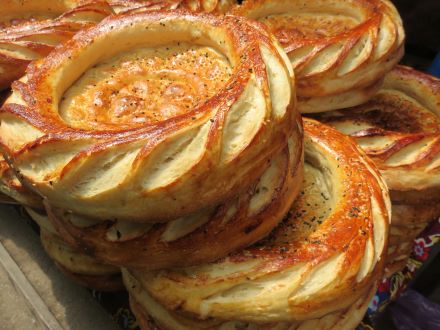
The verdict!
This is probably the most challenging trip we have ever done! Kyrgyzstan certainly pushed us to our limits, and there were many occasions when we wondered what we were doing there! At the same time, its spectacular scenery and heart-warming hospitable people make it one of those places that will continue to lure Darina back … next time with 2.6 inch tyres! Kurt is a whole lot more pragmatic with his choice of destinations and is quite happy to file Kyrgyzstan away as a once-in-a-lifetime experience!


Previous (Kazakhstan)


